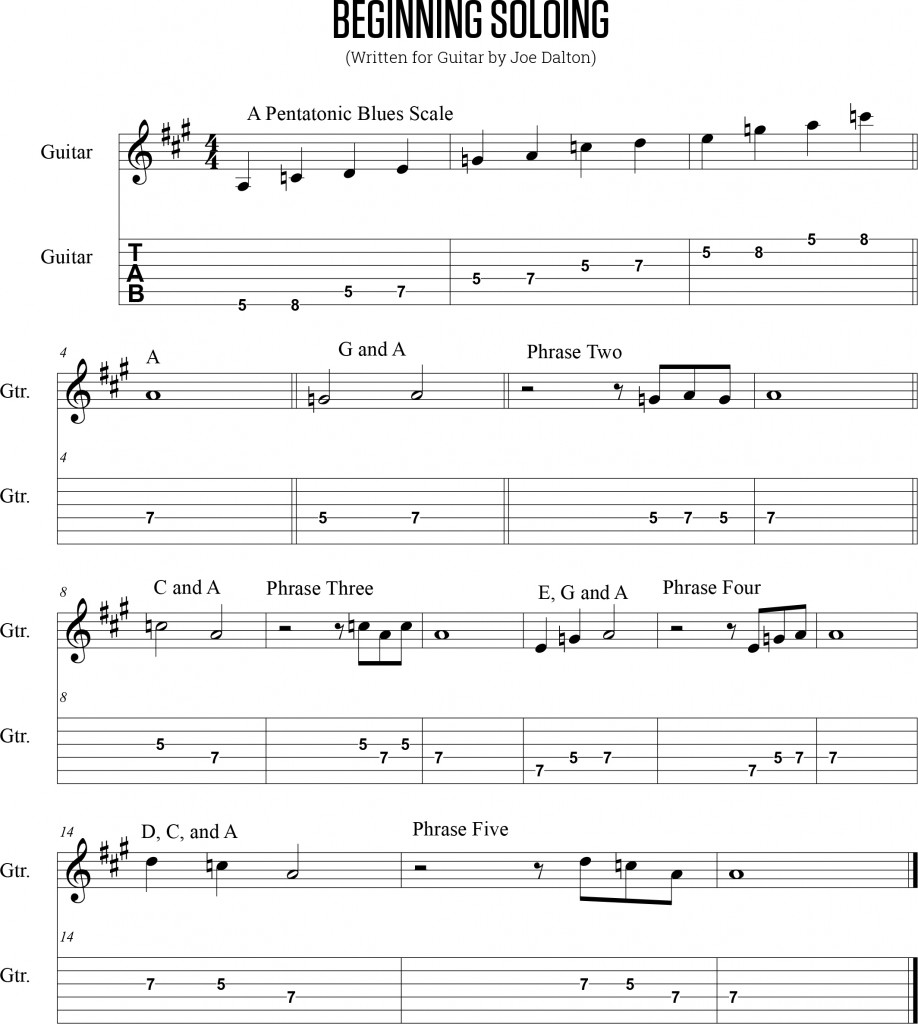Starting to develop the craft of single note soloing can seem like trying to stroll through the rainforest or climbing a mountain without a map, GPS, or guide. Some students (we are all students) may set out with a pentatonic blues scale, but don’t know where to begin. Interestingly enough, each one of us has our own unique voice when it comes to creativity and the craft of improvised solos. Let’s get started.
Along with your adventurous spirit (you must have one to even think about your stroll through the rainforest or climb up the mountain), we will need these basic tools:
Scales – Yes, we will need a collection of notes. To begin our journey, we will use a pentatonic blues scale.
Phrases – This is where most of us get lost. We try to play the scale from end to end. This sounds like we are taking a shot in the dark or don’t have a compass.
Dynamics – We need to give some emotion to our phrases. By changing volume and using different articulations, we can put some feeling into those notes we are playing.
I think this is a good start for one session. There is a lot more to learn, but of course, we need to start.
Scales – We will begin with the A Pentatonic Blues scale. Check the tab for this form of the scale. There are different positions and some that facilitate smoother scale sounds, but this is easy to memorize. Use your first finger for all of the notes on the fifth fret, your third finger for the seventh fret, and your pinky for the eighth fret.
Phrases – The most common error in creating your first improvised solo is trying to play the scale from A to A, trying to play all of the notes. Some of the most famous soloists use simple phrases to say much. (B.B King and Eric Clapton are the first two that come to mind.) We really need to center on the A and play fewer notes. Our first level of phrases for our journey, will be to center on the tonic. The tonic is the key name. We are in the key of A. We will use an A blues progression as our background and therefore, use the A blues scale to create our solos. We will be centering on the A.
1) The first exercise is getting used to the sound of our tonic and centering our phrases around the tonic. What I would like you to do is play your first chorus with just the A on the fourth string, seventh fret. This will enable you to be creative with your rhythms and articulations. This is just an exercise.
2) Now we need to add one note. Let’s add the G (the note below the A in pitch).
The G is on the fourth string, fifth fret. Always lead into the A. We want to land on the A so that it sounds like our home base. Don’t use too many notes. Try a phrase that is G-A-G-A, and hold out the last A. Play through the entire chorus with just this phrase.
3) Let’s add a note above the A. The C is on the third string, fifth fret. Play a phrase that uses just the C and the A, for instance C-A-C-A. After you play a chorus with just the C and the A, try alternating phrases of C and A with phrases of G and A. Always make A your “home base.” Land there and try to create space. Don’t try to fill all of the time noodling around with the notes. Keep it simple.
4) Well I’m certain you saw this coming. Now we will do the same thing with two notes below the A. E-G-A-A can be our next phrase. The E is on the fifth string, seventh fret. Play a chorus with this phrase.
5) Now we will do the same thing with two notes above the A. D-C-A-A can be our next phrase. The D is on the third string, seventh fret. Play a chorus with this phrase.
6) Try mixing things up a bit and you have completed the first steps in soloing around a tonal center. There are three different grooves for you to play along with as you develop and practice your new phrases.
Dynamics – Volume changes are self-explanatory. Try starting soft and getting louder and vice versa for each phrase. Try getting louder at the end of a chorus to lead you into the next one. As far as articulations go, try picking one note harder than the next to create and accented note. Play some long and some short.
Listen to some Eric Clapton and try to imitate some of his shorter phrases.
This is your jump-off point for improvised solos. There are some other elements we can add at another time like adding some cliché licks, flashy licks, bends, etc. For now get comfortable and confident with these ideas.



